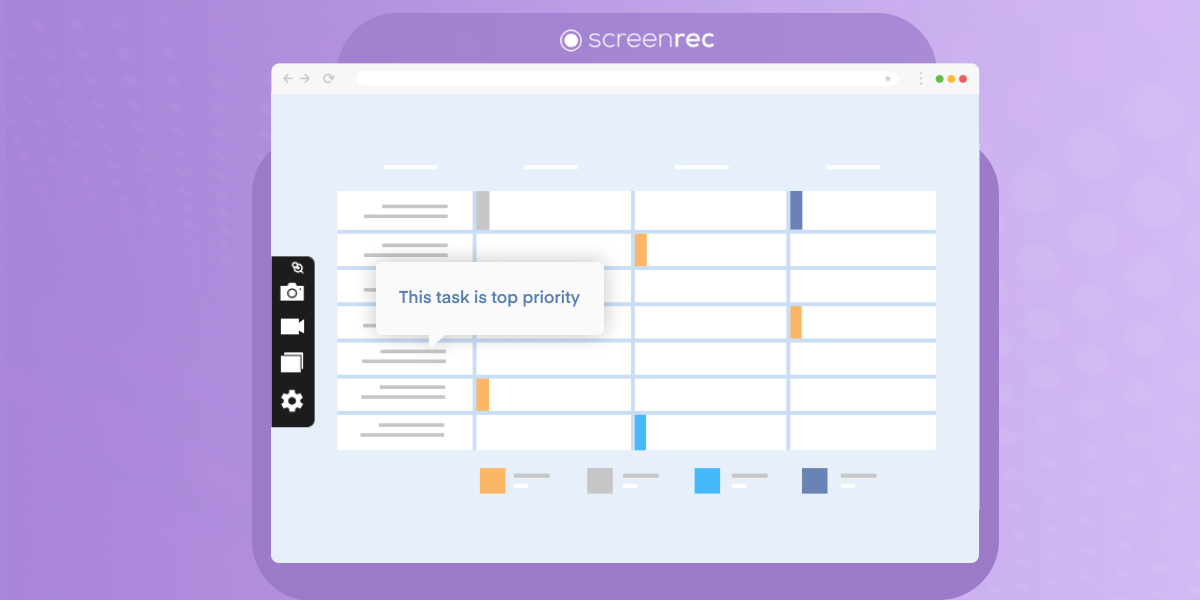The Only 7 Time Management Techniques You Need
We’ve all heard the phrase “time is money.” Well, according to an article published by Entrepreneur.com, more than 15 hours a week is wasted at work. William Penn said it best, “Time is what we want most, but what we use worst.”
This is a sad truth, but the truth nonetheless. So how can we avoid wasting time by implementing time management tips for work and become more productive?

By scouring the net and thumbing through page after page of research, we’ve come up with 7 time management techniques that are sure to bring productivity back to your workplace and ultimately save you money.
Why is time management important?
Before we get into imit, it’s best we understand why learning how to manage time effectively is so important.
- Get more stuff done
The obvious benefit of managing your time better is having more time to complete your work. How often do you find yourself saying “There are not enough hours in the day.” We all often spend hours not doing anything truly productive. If you weren’t wasting your days away, you may find that you’ve accomplished a lot more today than you did yesterday.
- Less stress
With those added hours, you can begin to truly take your time. There’s less urgency and a reduced need to rush. Whether you're trying to deal with stress from college or the stress of publishing your first book, managing your time better will enable you to relax and breeze through your work without worry.
- Feeling of satisfaction
With poor time management, you may find yourself toiling away from dusk till dawn without completing your most important tasks. If you can properly manage your time, you’ll have more time to do what matters and you’ll feel satisfied.
- Restore your drive
If you know exactly how you’re going to spend your time, you’ll be much more inclined to work diligently and possibly with a sense of determination.
- Promotion?
Obviously, this isn’t guaranteed, but explore it as a possibility for a moment. Let’s say your newfound drive and feeling of satisfaction has led you to your continuous positive work ethic.
Before you know it, your boss starts to take notice and soon you’re up for a promotion. Sounds good, doesn’t it? It’s very plausible!
So without further ado, here are 7 effective time management strategies that will improve your everyday life at work.
Time Management Techniques To Set Priorities and Goals
Technique 1: The Eisenhower Matrix
As made famous by our 34th president (before he became a president, however) the Eisenhower Matrix is a technique that helps you organize your to-dos in four separate quadrants.; “Do first”, “Schedule”, “Delegate”, “Don’t do”. This method is the perfect way to prioritize and complete everything that needs to be completed.

Technique 2: The Pareto Principle (80/20 rule)
Originally an idea put forth by Vilfredo Pareto but brought to the 20th century by Joseph Juran, the 80/20 rule is a concept that states that of a total number of events, 80% of the results are due to only 20% of its causes.
When Pareto realized this fact, it was in regards to the people of Italy and its economic situation. According to him, Italy was divided into two factions; “the trivial many” (aka the 80%) and the “vital few” (aka the 20%.) He stated that of the 100% of the wealth in the country, 80% of it was owned by 20% of the population.
But how does this convert into a time management technique? Looking at your to-do list, you can apply this rule and realize that 80% of that list is trivial while 20% of it is vital. If you have a list of 10 tasks, choose 2 that are most vital and complete those first. This will help you prioritize and keep your goals in check.

Example: When prioritizing, you need to determine what is urgent and what can wait. You’ll find yourself asking “Is this necessary?”
One thing that can usually be eliminated is non-urgent meetings. Meetings are time-consuming and often boring. So ask yourself, “Can this meeting be avoided?”
A good way to replace these time wasters is to use a free screen recorder like ScreenRec. ScreenRec will allow you to record your computer screen and voice simultaneously. So instead of forcing everyone to meet at a certain time, you can record your presentation and send it to your colleagues as a secure link.
Time Management Techniques To Eliminate Non-priorities
Technique 3: The D.E.A.L. Method
At some point, we’ve got to learn to stop overloading ourselves and delegate our tasks. Proposed by author Tim Ferriss in his book “The 4 Hour Work Week”, the DEAL system states that our work can be broken down and placed into four categories; Delegate, Eliminate, Automate, and Liberate. D.E.A.L.
Delegate: If there is a task that must be completed, ask yourself, are you the one that has to do it? If not, delegate it.
Eliminate: Some tasks may have no place on your to-do list. Think back to the 80/20 rule. If it’s a part of the trivial many, then you can probably get rid of it and focus on the vital few.
Automate: With so many apps available, it’s becoming easier and easier to leave certain tasks to an automated system, like a mass email system or something as simple as an online calendar.
Liberate: Some tasks are more difficult than others and require more time. Sometimes you should simply defer it. Put it on the back burner until you get the quicker tasks completed.

Example: You can use an all-around team management app to help improve your time and workload management skills. This will allow you to delegate tasks to team members, eliminate tasks, use the app’s features to automate them, and create new due dates as you defer. Asana is a great example of such an app.
Time Management Techniques To Organize Tasks & Set Deadlines
Technique 4: ABC System
Brought to us by Alan Lakein in 1973, the ABC system is a method in which tasks are placed by a matter of importance. Jobs categorized as “A” are established as the most important. “B” tasks are the next most important and “C” tasks are the least important.
The ABC method can also be used to measure the amount of time an assignment should take. “A” tasks will be completed in a day, “B” – in a week, and “C” – in a month.

Time Management Techniques To Implement Goals
Technique 5: Eat the Frog
As crazy as this sounds, this very reasonable technique was introduced by author Brian Tracey in his best-selling book “Eat That Frog”. He says,
“If the first thing you do each morning is to eat a live frog, you can go through the day with the satisfaction of knowing that that is probably the worst thing that is going to happen to you all day long.”
In other words, get the hard stuff done first. Create your list of goals and knock out the most difficult tasks before anything else.

Technique 6: GTD (Get Things Gone)
Also called the 2-minute Rule, the Get Things Done method was created by David Allen. Basically, the idea is to complete the smaller assignments right away and break the larger tasks into smaller assignments that can be completed immediately.
This time management technique keeps your brain from being overworked and avoids an overload of information which is bound to happen when you have dozens of tasks to complete. The goal of GTD is to encourage individuals to really map out their tasks and thoughts on paper to get organized and completed as well as teach them how to improve time management skills at work.

Technique 7: Pomodoro Timers
An idea originally conceived by Francesco Cirillo, the Pomodoro Timer Technique is a method centered on the idea that when your work is being timed, you’re more likely to focus and complete it. The name “pomodoro” is Italian for “tomato” and comes from a tomato-shaped timer used by Cirillo. Said to be a 25-minute timer, Cirillo used this tool to develop the idea that if an assignment should be comprised of 25 minutes of working and 5 minutes of break time.

Example: If you find yourself managing a sizeable team, you can easily use the GTD technique to handle tasks for the whole team. Everyone can apply this method to their to-do lists and before you know it, they’ve learned how to manage time wisely and all assignments are being completed on time.
Even More Time Management Techniques
In our opinion, these are the most effective time management techniques to increase productivity. But let’s be real, there are dozens of techniques and methods available to you. Here are even more:
Kanban | A method that uses columns to organize tasks and ideas. |
Timeboxing | The act of allotting a specific amount of time to each assignment. |
Time Blocking | The act of mapping out EVERYTHING you will do in a day. |
Inbox-Zero | A method that helps you to heavily manage your email so that your inbox remains at zero. |
Who’s Got the Monkey | The idea that you take on other people’s problems and tasks instead of focusing on your own. |
Action Method | A method that helps you put your ideas into actionable tasks. |
Biological Prime Time | A technique that helps you to determine which hours of the day you are likely to be most productive. |
The Productivity Journal | A method in which you record all of your tasks and ideas, when they should be completed, and how. |
The Seinfeld Method | A method given to a fan as advice by comedian Jerry Seinfeld, that suggest you work toward your goal daily, no matter what. |
The 10-minute Rule | A rule that states everything should be separated into ten-minute intervals. |
To-Done List | A list of everything you’ve accomplished. |
To-Don’t List | A list of everything that is not worth your time. |
Flowtime Technique | Alternative to Pomodoro Timer |
Top Goal | A method where you write down your goals, select the most important goal, and then set time to work on it every single day. |
POSEC Method | A method that encourages you to “Prioritize by Organizing, Streamlining, Economizing and Contributing” |
Wrapping Up
Clearly, there are MANY time management tools and techniques that we can implement to become better time managers and really amp up our productivity at work. Whether that’s using apps like ScreenRec or doing something as simple as eliminating trivial tasks, it doesn’t take much. So do yourself a favor, now that you know why time management skills are important, give your workload a complete overhaul.
When you start working on your time management skills, don’t forget to try sending a video message instead of an email. It’s so easy that you can get addicted… Get ScreenRec and try it now.
Frequently Asked Questions
First off, if you feel you don't have exceptional time management skills, it's not just you. Most people struggle daily to juggle between career and family, while still trying to find time for themselves. That being said, the most common causes of poor time management are The major causes for not managing time very well are absentmindedness, procrastination, ineffective delegation, being reactive instead of proactive, lack of clear plan, inability to prioritize. Many times such behavior can be caused by depression, lack of proper nutrition and lack of good night's sleep.
Most apps recommend this length but there are no hard and fast rules about how long a Pomodoro should be. This often depends on the type of work you do. To figure out the optimal Pomodoros for you, track your time for about a week and see how often you naturally take a break.
That depends on what you need to accomplish. The most basic time management tools are to-do lists and timers. To-do lists help you gain a realistic view of your workload and prioritize while timers help you understand where you really spend your time and help you stay focused.




![Top Project Management Tools To Save Time [Comparison]](https://screenrec.com/assets_dist/screenrec/media/top-project-management-tools/top-project-management-tools.png)





DON’T MISS OUT
Get updates on new articles, webinars and other opportunities: